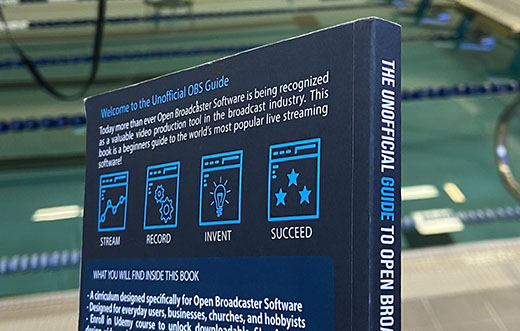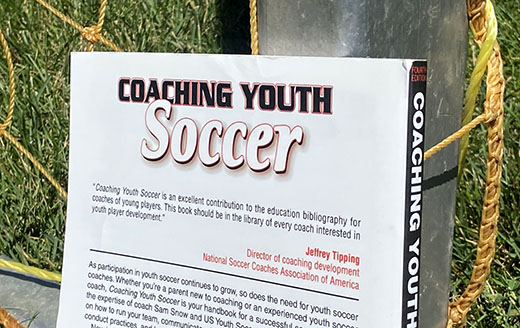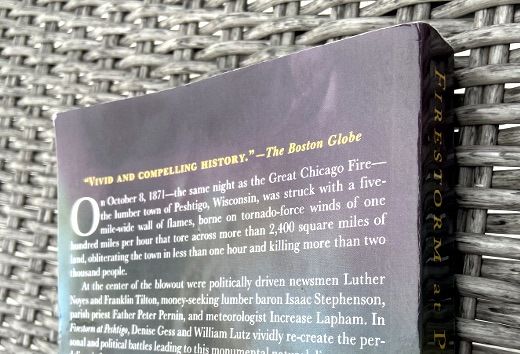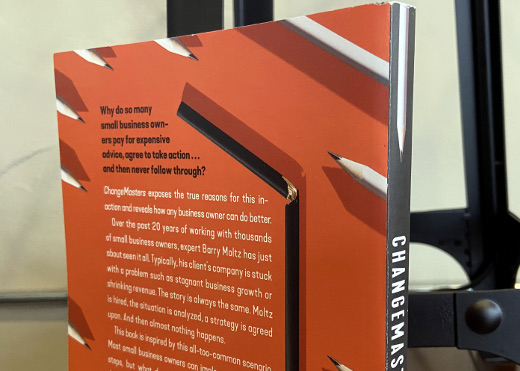My Takeaways From The Unofficial Guide to Open Broadcaster Software

As I have talked about before at great length, when I entered the world of livestreaming I literally dove head first into the pool and checked for water afterwards. Pun intended, as I have been livestreaming swim meets going on 2 years now. Within a short amount of time I was able to learn the basics and do a good job with that knowledge.
Through all of this I knew there was more to it, especially as there’s a number of resources available online about livestreaming. Where searching on topics has yielded me decent results, I also wanted to put some structure around my learning journey.
My quest led me to the book The Unofficial Guide to Open Broadcaster Software by Paul Richards. It is based on a class his firm Streamgeeks offers on the Udemy learning platform. As I have watched several of his videos and this was one of few printed books available on the OBS software we use to manage the livestream, I decided to buy a copy of it. Note you can request a PDF download of the book for free by filling out a form.
This book did not disappoint – it provided in a narrative style a top-down approach to livestreaming, chock full of examples and diagrams to provide a complete package of learning. As I went through the pages, I had the following takeaways from this book.
Provided the structure I needed – As a GenXer, my historical approach to learning is far from digital-first. Where I have taken many online courses that had no printed or tangible materials, it was refreshing to be able to have this printed book, carry it with me and read from cover-to-cover. The organization was just right and it gave me structure I would never have gotten from a YouTube playlist.
Validated a lot of what we are doing – With the approach I took with livestreaming, coming at it from all angles, I wondered how much I wasn’t doing that I should be. After reading this book, I did find a few things I wished I knew up-front. However it validated much of what we had done, and that gave me a great feeling. Granted we got compliments from many people on the end-product, but it’s also good to know we have used best practices to that end.
Learned plenty of tips – As I read the book, I took a lot of notes. Many notes were on things we haven’t done, and others were on what we were doing and options to consider. The list is something I am now working from to enhance our livestreaming process.
I highly recommend The Unofficial Guide to Open Broadcaster Software to anyone who is thinking about livestreaming or is already doing it, like myself. Certainly there are technical aspects to the book that may be beyond someone’s comfort zone, but if you’re looking to getting into livestreaming, they are important to learn and explore. There is a second edition to the book that I have also read, OBS Super User Guidebook: The Best Open Broadcaster Software Features & Plugins, that builds on the first edition and a writeup of takeaways from that would be similar to this one. This book too is available in print format or as a free PDF download. I plan on writing a follow-up to my original blog post on what I learned of livestreaming swim meets and will include these tips in that post.
As I share all books I read, I passed this copy along to one of my fellow livestreaming Swim Dads, someone who has been a great partner with me on this broadcasting journey, so he can share in the information and motivation to improve our livestreams.
This is from The Hot Iron, a journal on business and technology by Mike Maddaloni.
Did you enjoy this? Subscribe to The Hot Iron by RSS/XML feed or Read by Email
Book Take-Aways • (0) Comments • PermalinkMy Takeaways From The Book Coaching Youth Soccer

A couple of years ago my universe started on a collision course with another, as one of my kiddos decided to take up soccer. What started slowly quickly picked up quantum momentum to the point she had taken to the wing and goalkeeper positions, with the latter leading her to winning a local qualifier for a national goalie competition she played in this summer.
Where her and my other spawn were both swimmers, I had one body of knowledge to grow and learn about. Now I had another. Where I was picking up tips on the game from other parents who were lined up along the sideline of the field, I didn’t know all I didn’t know about the game. To that end, my wife picked up for me a copy of Coaching Youth Soccer by American Sport Education Program – not that I would be the team coach (we actually have some awesome coaches) but that I could understand better who was in what position and actually see an offsides before the referee called it.
Coaching Youth Soccer is a comprehensive book, talking about the type of person who can be a coach and all to think about, above and beyond who is kicking the ball to whom. Illustrated with diagrams and photos, I was able to easily follow along, noting takeaways as I learned what my kiddo has obviously already learned.
There’s a lot more to soccer than I thought – Your humble author actually played soccer for 2 seasons. As this is the first time I have ever mentioned it on this humble blog, you are accurate to assume I was not that good. Going into her playing and prior to reading this book, I did know you should not kick the ball with your toe and you should wear shin guards, among a few other basics. From the types of kicks, passes, formations and how they advance as the players age up, there was a lot to learn here. I can’t say after I finished the book I knew and remembered it all, but it gave me the foundation from which I can build on.
Teaching and coaching – Most of my exposure to sports coaches have been through swim and the NFL. Where for the latter I only had distant awareness of the actions of coaches, through swim I recognized what makes a good coach, not to mention what results in a bad coach. This book opens up talking about this and other aspects of the role of a coach – including as a teacher – long before gets into fundamentals. Though all styles are as unique as the individuals, there’s a common thread for good coaches that is obvious in the enjoyment of the game by the player and success of the team.
Not something I want to do – Where I have managed technical teams and software projects of various sizes, coaching a team of about a dozen and a half kiddos is not something I want to do. There are other aspects of the team I am more than glad to contribute to, but coaching is not one. Granted I have filled in when coaches were stuck in traffic on more than one occasion, but I will leave this to the people who are great at it.
Coaching Youth Soccer was a good read and one I actually have gone back to once or twice since I finished it. As it was endorsed by US Youth Soccer, the governing body of the game for kiddos, it is authoritative yet approachable. If you are new to the game or considering stepping up to be a coach, I recommend reading the book. Note the version I read was the fourth edition from 2006 and likely there have been updates, so picking up a more recent copy may be in order if you’re more than a casual reader of it like I was.
As I pass all books along to others after I read them, I am going to offer this to other parents on her team. There’s a mix of parents who actually played the game and those who haven’t, so there may be interest in someone to better understand their kiddos current (and future?) passion. In the meantime, I am still on the quest to see an offsides before it is called.
This is from The Hot Iron, a journal on business and technology by Mike Maddaloni.
Did you enjoy this? Subscribe to The Hot Iron by RSS/XML feed or Read by Email
Book Take-Aways • (0) Comments • PermalinkMy Takeaways From American Marxism

Words matter. And over the last few years I have heard words and phrases used by people describing both themselves and others in ways I haven’t heard in a long time, or ever.
One such word is Marxist, and it is one that has been both applied to oneself or others in a very broadstroke way. This is not a descriptive term I am completely unfamiliar with, yet it is one I am not completely understanding of its meaning either. So when I got a copy of American Marxism by Mark Levin for Christmas this past year, I was intrigued to read it. My hopes were that it would help me understand the 5 H’s and 1 W of the use of the descriptor.
As I read through American Marxism, I kept this personal goal in mind and do so now as I reflect on my takeaways from it.
This book is not a history on Marxism – Marxism comes from Karl Marx, a 19th century German writer and philosopher. From my experience, especially as someone who hasn’t studied him before, his philosophy is to the left of the political spectrum and is often compared with Socialism and Communism. Add the word “American” it and one can assume it applies to similar people and beliefs in the US. But rather than start from the beginning, it starts in the middle and makes assumptions of knowledge of many of the people mentioned in the book. Saying that someone is a Marxist is not a definition of the term, but inferences can be made.
Degrowth – I have never heard of this term previously, and thus was new to me. My own personal high-level definition is that it is the opposite of growth, encompassing everything from economic development to population growth. This is something in itself I may want to explore more, especially as it is presented in the context of Marxism.
I like Capitalism – Where there are both good and bad in everything we do, I personally believe that free societies where people know what’s best for them as well as free markets are the way to go and we have a robust society as a result of it. Granted not everyone shares in this, but there are many complex reasons for this.
The author of American Marxism, Mark Levin, is a conservative radio talk show host, and my guess is this book is written for his audience and not looking to reach a broader audience, similarly to other politically-oriented books I have read. As someone who doesn’t have a firm footing in one place on the political spectrum, reading American Marxism helped me understand better how some observe those who apply this term to themselves, or who don’t but others apply it to them. Where words matter, so do actions, and no matter where someone’s beliefs are, perhaps we shouldn’t focus as much on labels.
If the title of this book intrigues you then I recommend American Marxism. There were many people introduced in this book that I was not familiar with and would require more research as to their background and fully what they said beyond quotes, but it is a well-written and quick read on the topic. As I pass along all books, this one is going to someone whom I am sure the title would resonate with.
This is from The Hot Iron, a journal on business and technology by Mike Maddaloni.
Did you enjoy this? Subscribe to The Hot Iron by RSS/XML feed or Read by Email
Book Take-Aways • (0) Comments • PermalinkMy Takeaways from Firestorm at Peshtigo

Even the most casual observer of history will know about the great fire in Chicago, Illinois in the US in 1871. From the legend of Mrs. O’Leary’s cow to the city’s destruction and rebirth, it is the stuff of legends. But do they – or you – know of a fire equally as intense that likely killed ten times as many people… just a few hours away… on the same day?
Don’t feel bad if you don’t – I didn’t either until I moved closer to where that second fire was and read a story about it, Firestorm at Peshtigo: A Town, Its People, and the Deadliest Fire in American History by Denise Gess and William Lutz.
Peshtigo, Wisconsin today is a small city surrounded by a town of the same name and located in northeast Wisconsin, not too far from where what you are reading was written. In comparison to its former self before the fire in 1871, it pales in comparison. Even with its proximity to me, I have never been there and never hear much about it otherwise. But that former self was quite an industrial city in its time, as it was the home to forest logging, wood mills and the manufacturing of wooden products.
Gess and Lutz dig into the history of the area from a variety of sources and have crafted a tale of good times and bad and the people affected by it. As I was intrigued by the story that claimed the lives of at least a thousand people, I of course had several takeaways from it.
There was something always burning – The forests of Wisconsin and the upper US Midwest were home to an abundance of trees. Common practice was to cut down trees and burn the remaining tree stumps so that the land could be used for farming. As a result it seemed like there was always something burning in and around Peshtigo, and that is perhaps why people did not flee the area as quickly before the fires reached their pinnacle.
The beginnings of meteorology – Today it’s too easy to see the weather forecasts down to the hour, but that was far from the case in the late 1800’s. That being said it was the earliest days of weather tracking and meteorology that got its start in the military services. From this tracking it was observed that the temperatures in the area were extremely hot and dry for October and as well there were fires and tornadoes not only in the Peshtigo area but in several cities along Lake Michigan.
Ties between Peshtigo and Chicago – Speaking of Lake Michigan, more than the weather were a bond between these two cities that are located by it. William Ogden was an industrialist from New York and the first mayor of Chicago among other contributions to that city. He also owned a mill and woodenware factory in Peshtigo. He was back in New York on October 8, 1871 and traveled back to the Midwest after he heard the news. His promises to rebuild in Peshtigo never materialized and with the fires went that great industry of the area.
I need to visit Peshtigo now – Reading Firestorm at Peshtigo reminded me of when I read The Great Halifax Explosion and I vowed to one day visit that area. As I am so close to Peshtigo it is on my short list of places to go this summer. The history geek in my will want to take it all in, though I am not sure if the family will share the same enthusiasm in it, but there’s one way to find out.
Firestorm at Peshtigo was a well-told tale of history, and I highly recommend it not only to anyone who lives in the area where Peshtigo is, but anywhere who has an interest in such a sad but unique time. At the end the book the notes section is probably the best I have read in a non-fiction piece, as it is a narrative and not just a clinical list of references. Calling back the family reference, it was my wife’s cousin, a retired librarian, who recommended the story to me. As I pass along all books I read, I am sending it to my own cousin, who is also a retired librarian, as I know she is a voracious reader and I think will equally enjoy this story.
This is from The Hot Iron, a journal on business and technology by Mike Maddaloni.
Did you enjoy this? Subscribe to The Hot Iron by RSS/XML feed or Read by Email
Book Take-Aways • (0) Comments • PermalinkMy Takeaways from ChangeMasters
If you or I were to stop what we are doing right now and make a list of things we would like to change in our lives, it would likely be an easy task. Whether the list is short or long, there is something we likely want to be different than it is now. So why haven’t we changed those things? This is the premise of ChangeMasters – How to Actually Make The Changes You Already Know You Need to Make - the latest book by small business guru Barry Moltz.
In this lively read, Moltz starts by introducing change by getting into why we are resistant to change, offers a tool to help us analyze change, then gives some areas where we could make change in our businesses, and thus in our lives. As I read this cover-to-cover, I could relate to what he wrote about, and had the following takeaways.
It’s Easier to Not Change – From not cleaning our office to not reviewing bank statements, it’s easier to not change to do these things. Much of this is biological – there’s 2 chapters that specifically get into this. Where Moltz says you can skip over these, I highly recommend reading these well-researched passages to get an idea of how our brains are actually wired against change.
Take Baby Steps – You have to start somewhere and to this end there’s a 20-step Change Worksheet that can help you assess issues and make a plan to execute on them. Don’t be intimidated by the number of steps; the questions may be tough but are straightforward if you are serious about making change.
Not Just For Small Businesses – Where the book is written by a small business consultant and geared to small businesses, the first half of the book offers guidance that can be used by anyone personally.
I’m So Vain – In the introduction of the book, Moltz poses the question as to why small businesses hire him to help them make change, yet they don’t do it. I can relate to this remark as I had hired him as a coach back in the day for my own small business. Where I knew I posed a challenge to him as to where to begin to work with me, he successfully helped me develop a new product offering for my business. I only worked with him for a short time – it was me, as I didn’t have sufficient cash flow (or so it seemed) and though he wanted to make things work for me, I cut off the working relationship. I can only speculate how things may have been better with my business if we continued, but I certainly count myself as one of the reasons for why he wrote this book.
ChangeMasters is an enjoyable read and structured in a way where you can identify areas for change with examples and tactics to execute on making change. Where I opined earlier the first half of the book is really geared towards everyone, the second half gets into specific areas that may be a challenge for any business, including customer service, sales and marketing and managing money. I highly recommend this book to any small business owner – even if they believe they are constantly changing as needed, it will then serve as an affirmation to their efforts. But in all reality there is something we can all do better and this book is here to help.
As I give away all books I read, this one was passed along to a small business owner I know. Where we have had many conversations about be in business for yourself and I believe they are on top of things, there’s always room for improvement, and hopefully this book will help. I did however capture the 20-step Change Worksheet for my own personal use in the near future.
This is from The Hot Iron, a journal on business and technology by Mike Maddaloni.
Did you enjoy this? Subscribe to The Hot Iron by RSS/XML feed or Read by Email
Book Take-Aways • (0) Comments • Permalink

